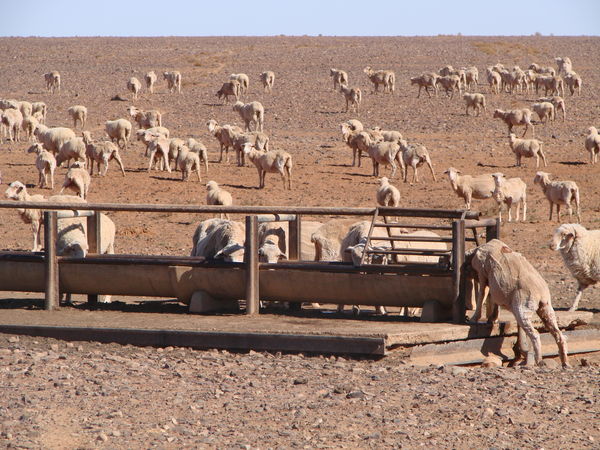Over summer it is important for stock to have access to clean, cool water. Water consumption by sheep can increase by 80% in extreme, hot conditions. Weather conditions are only one factor that influences stock water requirements. It is important that water flow into the stock trough is fast enough to allow all the livestock in the mob to quench their thirst.
Sheep tend to move in mobs and when they arrive at a trough, the dominant animals will drink first and may empty the trough. When the dominant sheep have had their fill, they move off and the rest of the mob may go with them, leaving the more timid sheep without a drink if the water flow rate is too slow.
Water in longer troughs tends to become stagnant, contaminated with dust, dirt algae, bees and bird droppings. They require cleaning out more often costing time and water loss.
Livestock will tend to drink closest to the trough inlet therefore troughs 2.4m – 3.6m should be adequate as long as the flow rate is 1 to 1.5 Litres per second. Changing the inlet riser from 32mm to 50mm diameter will increase the flow rate to supply 1000 - 2,000 sheep. Flow rates need to be increased to 1.5 – 2 Litres/second for mobs of 2,000 – 3,000 sheep.
Storing water in a tank at or near the trough provides a greater recovery rate for the trough. The tank can then slowly fill overnight. Tank size will depend on stock numbers and reliability of the water supply. Tanks should hold a minimum of three days’ supply in case of system failure. This is particularly useful if water is piped long distances, flow rate is slow, poly pipe is not buried resulting in hot water and reduces the risk of stock running out of water due to water leaks. Research has shown that high flow rates into troughs encourage sheep to spend less time at the watering point and more time grazing reducing the potential for drift occurring around the watering point.

(Source: Farmonline)
Stock water plans should be based on the peak consumption of water per day in summer. Daily water consumption varies for different classes of livestock. It is also important to include salinity, feed type, size of stock, lactating animals, walking distance, and shade when calculating livestock requirements.
Sheep can drink 40% more in summer than winter, and 50-80% more if their water contains more than 2,000ppm total dissolved salts. Stock grazing on dry feed including hay and stubble or high salt containing plant such as saltbush will drink more water than stock grazing on green pastures.
When planning water supply requirements allow for evaporation loss, and include native animals in the calculations.
Stock should not have to walk more than 1.5 km to water. To determine the best placement of troughs and tanks, it is necessary to incorporate the stock water plan into the whole farm plan. For efficient grazing, water points should be centrally located in a paddock however that is not always practical. It may be preferable to install two troughs at each end in very large paddocks or place the trough half way along the fence line. Another option is to install rises along the pipeline and use a portable trough to encourage a more even grazing pattern. Design the placement of troughs to allow air flow underneath and around the toughs to reduce dirt, dust and manure being deposited on the water surface when windy. Troughs should not be located in areas with erosion potential, sheep camps or in vegetation.
With regular monitoring of stock water and reticulation system, stress and subsequent production loss can be minimised in hot weather conditions.
For further detail contact your local Livestock Consultant.